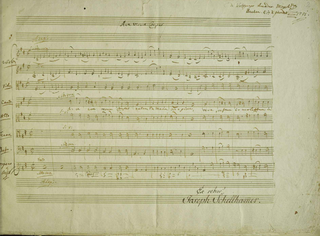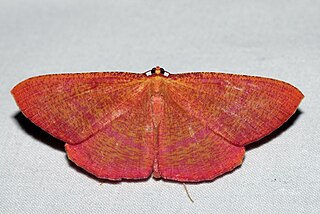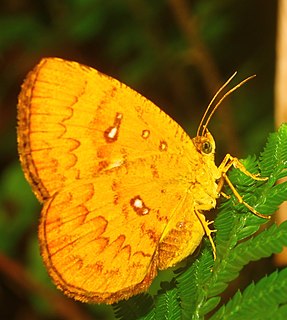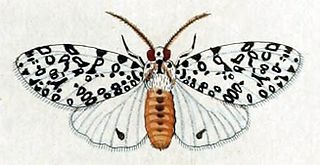
Tellervini is a tribe of danaid butterflies with only the one genus Tellervo, with six widely distributed species found in the Australasian realm and the Indomalayan realm. The taxon is apparently monophyletic, but its relationship with the other two danaid tribes is yet uncertain. The phylogeography of the group is also a challenge to those who hold to a Cenozoic origin of the butterflies.

Loxostege is a genus of moths of the family Crambidae.

Pycnarmon is a genus of moths of the family Crambidae described by Julius Lederer in 1863.

Phostria is a genus of moths of the family Crambidae.
Eloria is a genus of moths in the subfamily Lymantriinae. The genus was erected by Francis Walker in 1855.

Ave verum corpus, , is a motet in D major composed by Wolfgang Amadeus Mozart in 1791. It is a setting of the Latin hymn Ave verum corpus. Mozart wrote it for Anton Stoll, a friend who was the church musician of St. Stephan in Baden bei Wien. The motet was composed for the feast of Corpus Christi; the autograph is dated 17 June 1791. It is scored for SATB choir, string instruments and organ.

Eumelea rosalia is a species of moth of the family Geometridae described by Caspar Stoll in 1781. It is found from the Indo-Australian tropics of India, Sri Lanka, Myanmar, east to northern Australia and New Caledonia.

Callidula is a genus of moths of the family Callidulidae.

Acosmeryx anceus is a moth of the family Sphingidae. It was described by Caspar Stoll in 1781, and it is known from India, New Guinea, and Queensland, Australia.

Alpenus maculosus is a species of moth of the family Erebidae. It was described by Caspar Stoll in 1781. It is found along the Gold Coast and in Lagos, Sierra Leone, Guinea, Angola, Cameroon, Nigeria, the Republic of the Congo, Uganda, eastern Africa and Zimbabwe.
Euagra coelestina is a moth of the subfamily Arctiinae. It was described by Caspar Stoll in 1781. It is found in Suriname and the Brazilian state of Pará.

Hypercompe cunigunda is a moth of the family Erebidae first described by Caspar Stoll in 1781. It is found in French Guiana, Suriname, Brazil, Venezuela, Ecuador and Bolivia.

Thyrgis militta is a moth of the subfamily Arctiinae. It was described by Caspar Stoll in 1781. It is found in Bolivia, Suriname, Venezuela and Peru.
Poliopastea eacus is a moth of the subfamily Arctiinae. It was described by Caspar Stoll in 1781. It is found in Suriname and Pará, Brazil.

Parathyris cedonulli is a moth of the family Erebidae first described by Caspar Stoll in 1781. It is found in French Guiana, Suriname, Brazil, Venezuela, Ecuador, Bolivia, Honduras and Belize.
Pseudocharis melanthus is a moth in the subfamily Arctiinae. It was described by Stoll in 1781. It is found in Colombia and Suriname.
Lypotigris reginalis is a moth in the family Crambidae. It was described by Caspar Stoll in 1781. It is found in Suriname, Trinidad and Tobago, Central America, the West Indies and Florida.

Sternoptyx diaphana, the diaphanous hatchetfish, is a species of deep sea ray-finned fish in the family Sternoptychidae. It is the type species of the genus Sternoptyx, and was first described by the French naturalist Johann Hermann in Der Naturforscher 1781.

Elymnias vitellia is a butterfly in the family Nymphalidae. It was described by Caspar Stoll in 1781. It is found in the Indomalayan realm.
Flaccilla is a monotypic skipper butterfly genus in the family Hesperiidae described by Frederick DuCane Godman in 1901. It has one species, Flaccilla aecas, the aecas ruby-eye, described by Caspar Stoll in 1781. It is found from Mexico to southern Brazil.














